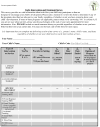Detecting, studying, and treating autism early: the one-year well-baby check-up approach
- PMID: 21524759
- PMCID: PMC3157595
- DOI: 10.1016/j.jpeds.2011.02.036
Detecting, studying, and treating autism early: the one-year well-baby check-up approach
Abstract
Objectives: To determine the feasibility of implementing a broadband screen at the 1-year check-up to detect cases of autism spectrum disorders (ASD), language delay (LD), and developmental delay (DD).
Study design: The Communication and Symbolic Behavior Scales Developmental Profile Infant-Toddler Checklist was distributed at every 1-year pediatric check-up; 137 pediatricians and 225 infants participated. Screens were scored immediately, and failures referred for further evaluation.
Results: Pediatricians screened 10 479 infants at the 1-year check-up; 184 infants who failed the screen were evaluated and tracked. To date, 32 infants received a provisional or final diagnosis of ASD, 56 of LD, nine of DD, and 36 of "other." Five infants who initially tested positive for ASD no longer met criteria at follow-up. The remainder of the sample was false positive results. Positive predictive value was estimated to be .75.
Conclusions: The 1-Year Well-Baby Check-Up Approach shows promise as a simple mechanism to detect cases of ASD, LD, and DD at 1 year. This procedure offers an alternative to the baby sibling design as a mechanism to study autism prospectively, the results of which will enrich our understanding of autism at an early age.
Copyright © 2011 Mosby, Inc. All rights reserved.
Conflict of interest statement
The authors declare no conflicts of interest.
Figures





References
-
- Zwaigenbaum L, Bryson S, Rogers T, Roberts W, Brian J, Szatmari P. Behavioral manifestations of autism in the first year of life. Int J Dev Neurosci. 2005;23:143–52. - PubMed
-
- Lauritsen MB, Pedersen CB, Mortensen PB. Effects of familial risk factors and place of birth on the risk of autism: a nationwide register-based study. J Child Psychol Psychiatry. 2005;46:963–71. - PubMed
-
- Landa RJ, Holman KC, Garrett-Mayer E. Social and communication development in toddlers with early and later diagnosis of autism spectrum disorders. Arch Gen Psychiatry. 2007;64:853–64. - PubMed
Publication types
MeSH terms
Grants and funding
- U24 MH081810/MH/NIMH NIH HHS/United States
- R01 MH081757/MH/NIMH NIH HHS/United States
- R01 HD065272/HD/NICHD NIH HHS/United States
- R01 MH083968/MH/NIMH NIH HHS/United States
- R01 MH036840/MH/NIMH NIH HHS/United States
- R01 MH081873/MH/NIMH NIH HHS/United States
- R01 MH080134/MH/NIMH NIH HHS/United States
- U01 NS061264/NS/NINDS NIH HHS/United States
- R01 MH089390/MH/NIMH NIH HHS/United States
- R01 MH078165/MH/NIMH NIH HHS/United States
- R01 AG022381/AG/NIA NIH HHS/United States
- P50 MH081755/MH/NIMH NIH HHS/United States
- L30 MH091755/MH/NIMH NIH HHS/United States
LinkOut - more resources
Full Text Sources
Medical
Research Materials
Miscellaneous

